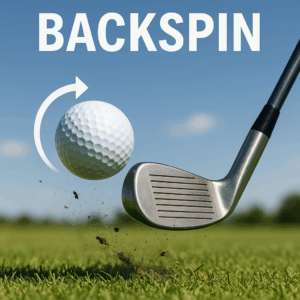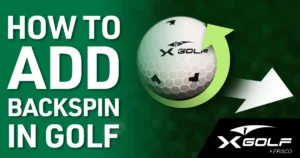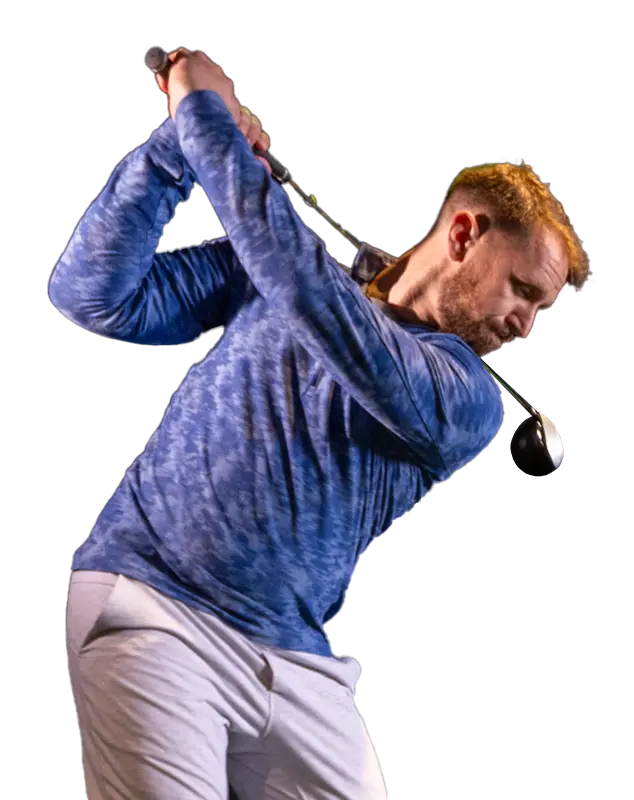The Science Behind How to Add Backspin in Golf
Learning how to add backspin in golf isn’t just about looking like a pro (though that’s pretty awesome too). It’s about gaining real control over your shots and improving your game in ways that will drop strokes from your scorecard. Whether you’re a weekend warrior or someone who dreams of playing like the pros you see on TV, understanding backspin can transform how you approach the game.
At X-Golf Frisco, we see golfers of all skill levels working on their backspin techniques in our state-of-the-art indoor golf simulators. There’s something special about being able to practice these shots year-round, regardless of weather conditions. Our advanced technology lets you see exactly how your ball is spinning, making it the perfect place to master this essential golf skill. But before we dive into where you can practice, let’s explore the fascinating science behind making that little white ball dance on the greens.
Featured within this blog for How to Add Backspin in Golf:
The Science of Backspin: Covering the technical aspects like spin rates, weather effects, and green conditions
Equipment Essentials: Ball selection, club choice, and groove maintenance
Top 5 Technique Tips : The numbered tips from your blog presented clearly with visual indicators
How Ball Speed, Loft, and Spin Rate Work Together
How to Add Backspin in Golf Tip 1: Make Sure Your Grooves Are Clean
Think of backspin like the engine that powers your golf ball’s behavior once it hits the green. Three main factors work together to create this magic: ball speed, loft angle, and spin rate. Understanding how these elements interact is the key to mastering how to add backspin in golf consistently.
Ball speed is exactly what it sounds like…how fast your ball is traveling when it leaves the clubface. But here’s the interesting part: faster isn’t always better when it comes to backspin. You need just the right amount of speed to create optimal spin. Too fast, and your ball won’t grab the green. Too slow, and it won’t have enough energy to create the spinning effect you want.
Loft angle is the angle of your clubface when it strikes the ball. Higher lofted clubs like wedges naturally create more backspin because they hit the ball at a steeper angle. This upward angle combined with a clean strike creates the conditions needed for backspin. It’s like throwing a ball upward with your hand – the angle creates natural rotation.
Spin rate measures how many times your ball rotates per minute. For good backspin, you want a high spin rate, typically between 8,000 to 12,000 RPM for wedge shots. Professional golfers can achieve even higher rates, but as a recreational player, focusing on consistent spin in this range will give you great results.
Choosing the Right Ball for How to Backspin a Golf Ball
How to Add Backspin in Golf Tip 2: Use a High-Spin Golf Ball
Not all balls are created equal. Choose a urethane-covered, tour-quality ball designed for spin.
Not all golf balls are created equal when it comes to generating backspin. The type of ball you choose can make a huge difference in your ability to create that coveted spinning action. Understanding golf ball construction will help you pick the right equipment for your backspin goals.
Compression rating also matters for backspin generation. Lower compression balls (around 70-80) tend to create more spin for slower swing speeds, while higher compression balls (90-100+) work better for faster swingers. Most recreational golfers benefit from medium compression balls that offer a good balance of distance and spin control.
The dimple pattern on your golf ball affects how it flies and spins through the air. Modern golf balls have sophisticated dimple designs that help maintain backspin during flight. While you don’t need to become a dimple expert, choosing balls from reputable manufacturers ensures you’re getting scientifically designed dimple patterns that support backspin generation.
How Temperature and Humidity Affect Golf Ball Spin for How to Backspin a Golf Ball
Weather conditions play a bigger role in backspin than most golfers realize.
Air density changes with temperature and humidity, which directly impacts how your ball flies and spins. In hot, humid conditions, the air is less dense, so your ball will fly differently than on a cool, dry day. These changes might seem small, but they can be the difference between a ball that stops on the green and one that rolls past the pin.
If you are suffering from the humidity, How to Beat the Heat on the Golf Course. can help with useful facts for all golfers in humidity.
How to Put Backspin on a Golf Ball in Cold Weather
Cold weather creates unique challenges for generating backspin.
In cold weather, focus on making cleaner contact with the ball. The harder ball surface means less time in contact with your clubface, so precision becomes even more important. Take an extra moment to ensure your setup is perfect, and don’t rush your swing just because you’re cold.
Consider using a softer golf ball in cold conditions. While your summer ball might work great in warm weather, switching to a lower compression ball when it’s cold can help maintain spin rates. The softer ball will compress more easily against the hard, cold clubface.
How to Put Spin on a Golf Ball in Wet or Damp Conditions
How to Add Backspin in Golf Tip 3: Play from a Clean, Dry Lie. Backspin is nearly impossible from rough or wet grass. Stick to clean fairway lies or tightly mown turf where your clubface can make crisp contact with the ball.
Wet conditions present different challenges for backspin generation. While you might think water would help create more spin, it actually reduces friction between your clubface and the ball. However, you can still generate good backspin with the right adjustments.
Clean, dry clubfaces are critical in wet conditions. Water and debris on your clubface will reduce the friction needed for spin. Towel off your clubs before every shot, and consider using multiple towels to keep them as dry as possible throughout your round. Focus on hitting down on the ball more
aggressively in wet conditions.

How to Get Backspin on a Golf Ball with Different Tools: Wedge vs Club
How to Add Backspin in Golf Tip 4: Use a Wedge with Higher Loft
Different clubs create backspin in different ways, and understanding these differences will help you choose the right tool for each situation. While wedges are the most obvious choice for generating backspin, you can create spin with various clubs when you understand the principles involved.
Wedges are designed specifically for creating backspin. Their high loft angles, sharp grooves, and specialized designs make them perfect for generating the spin you need around the greens. Sand wedges (54-56 degrees) and lob wedges (58-62 degrees) are particularly effective for creating maximum backspin on approach shots.
Short irons (7, 8, 9 iron) can also generate decent backspin, especially from shorter distances. While they don’t have as much loft as wedges, their grooves and design still allow for good spin generation when you make clean contact. These clubs are great for longer approach shots where you still want some stopping power.
Even mid-irons can create some backspin under the right conditions. While you won’t get the dramatic stopping action you see with wedges, proper technique with a 6 or 7 iron can still produce enough spin to help control your ball on the green.
How to Get Backspin on Hard vs. Soft Greens
Hard greens require more backspin to get your ball to stop. When greens are firm, balls tend to bounce higher and roll further upon landing. To counter this, focus on creating maximum spin with your wedges. Use a steeper angle of attack and ensure your grooves are clean and sharp.
Soft greens are more forgiving and actually help your backspin work more effectively. The ball will grab the surface more easily, so you don’t need quite as much spin to get stopping action. However, be careful not to under-spin your shots, as soft greens can sometimes grab the ball so well that it backs up more than you expect.
Adjust your landing spot based on green conditions. On soft greens, you can be more aggressive with your targets since the surface will help stop your ball. On hard greens, play more conservatively and use backspin as a safety net rather than trying to be overly precise.

Why Your Ball Isn’t Spinning: Common Mistakes and Fixes
How to Add Backspin in Golf Tip 5: Practice with Purpose
Use indoor simulators or launch monitors to track spin rate and ball behavior. Repetition with feedback helps you understand how ball position, swing speed, and club choice affect spin.
Many golfers struggle with backspin because they’re making common mistakes that prevent proper spin generation. Understanding these issues and how to fix them will help you start creating the backspin you’ve been working toward.
- The most common mistake is trying to help the ball into the air by scooping at impact. When you try to lift the ball up, you’re actually reducing the descending blow needed for backspin. Instead, focus on hitting down on the ball and letting the loft of your club do the work of getting the ball airborne.
- Dirty or worn club grooves are another major culprit. Grooves create the friction necessary for backspin, so when they’re filled with dirt or worn smooth, you lose your ability to generate spin. Clean your grooves regularly and replace clubs when the grooves become too worn.
- Poor ball position can also prevent good backspin. If your ball is too far forward in your stance, you’ll catch it on the upswing rather than the downswing. For most backspin shots, position the ball in the center of your stance or slightly back from center.
- Deceleration through impact kills backspin.
- Using the wrong technique for your swing speed also causes problems. Slower swingers often need to focus more on clean contact and proper angle of attack, while faster swingers need to work on controlling their power to maintain consistent spin rates.
Looking for Indoor Golf Near Me? Check Out X-Golf Frisco!
Now that you understand the science behind backspin, you’re probably eager to start practicing these techniques!
What makes X-Golf Frisco special for practicing backspin is our advanced simulator technology. Our systems track every aspect of your ball flight, including spin rate, launch angle, and ball speed. You can see exactly how much backspin you’re generating with each shot, making it easy to understand what’s working and what needs adjustment.
If you want to learn more about X-Golf Frisco, home to indoor golfing simulators, visit us!
X-Golf Frisco corporate event space for indoor golf and X-Golf Frisco’s golfing simulators during group activities provide a fun way to practice backspin techniques with friends, colleagues, or family members. There’s something motivating about working on your game alongside others who share your passion for golf. Plus, our professional instructors can provide personalized tips to help you master the backspin techniques we’ve discussed.
Whether you’re a beginner just learning how to add backspin in golf or an experienced player looking to refine your technique, X-Golf Frisco offers the perfect setting to improve your game. Learning backspin techniques becomes more enjoyable when you’re surrounded by others who understand the satisfaction of watching a well-struck shot check up on the green.
Wow! Congrats for reading this far! Since you liked this one we recommend: “How to add backspin in Golf,” we recommend that you learn ‘Why Golf is the Hardest Sport” presented by X-Golf Frisco golfing event spaces.


